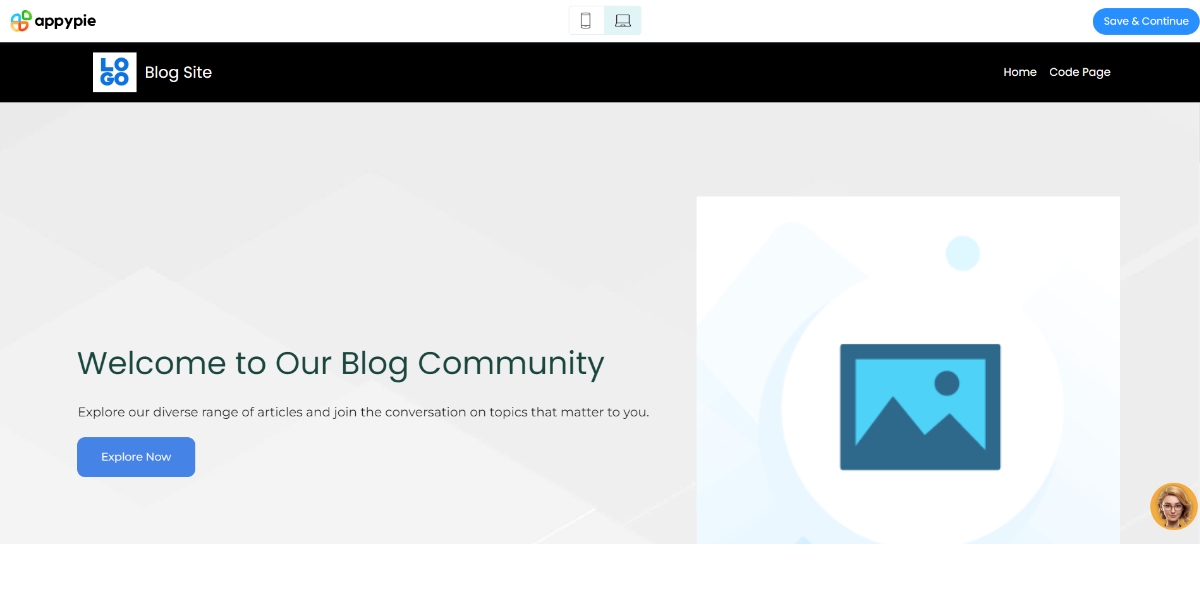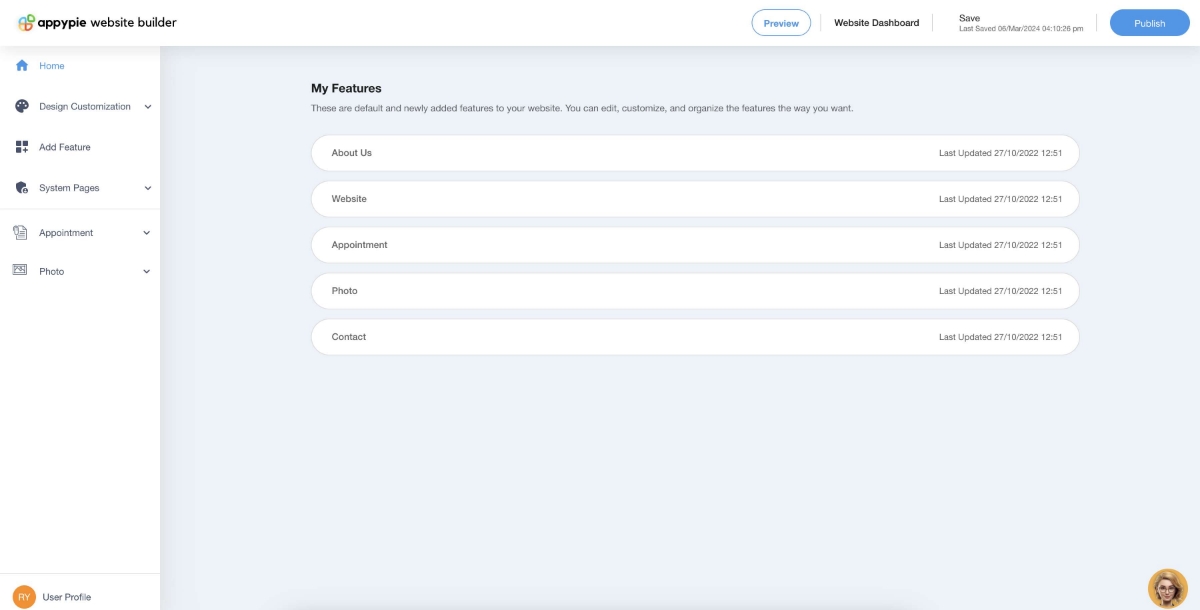Appy Pie For Blogging: 6 Simple Steps To Getting Started

Starting a blog is an exciting way to share your thoughts, ideas, and expertise with the world. In today's digital age, blogging has become an increasingly popular platform for individuals and businesses to connect with their audience, establish themselves as thought leaders, and even generate income. Whether you're a writer, hobbyist, or entrepreneur, creating a blog can be a rewarding experience. This guide will walk you through the essential steps of setting up your blog, ensuring its success, and promoting it effectively.
How to Start Your Own Blog Website with Appy Pie?
Appy Pie is a user-friendly platform that simplifies the process of creating and managing a blog. With its intuitive interface and comprehensive features, Appy Pie's Website Builder empowers you to build a professional-looking blogging website without requiring extensive technical knowledge.
Learn how to create a blog website in a few simple steps. So, let’s get started.
Step 1: Go to Appy Pie's website builder
Go to the home page of AI Blog website builder of Appy Pie and discuss your website ideas with the help of a prompt and click on ‘Create Now’.

Step 2: Customize Your Website
With the help of AI, the platform will make a ready-to-use website for you that can be personalized or customized according to your needs. Now click ‘Save & Continue’ present at the top right corner.

Step 3: Add features
After landing on the dashboard of your website, click on ‘Edit’ to add features of your choice.

Step 4: Go to website dashboard
Once you have your favorite features, alter the website layout, and website elements, then select ‘Website Dashboard’.

Step 5: Choose a domain name
Connect your domain with the website. If you don’t have any domain you can easily purchase a new one from Domains.

Step 6: Test & Publish
Now, preview your website to look out for sneaky bugs and errors. Once the website is up to your needs, hit ‘Publish’.

By following these steps, and with the guidance of Appy Pie experts, you can create a professional and effective website that showcases your expertise and attracts clients to your business. Additionally, it offers web hosting, stunning templates, and domain services.
Best practices for a successful blog
To ensure your blog's success, it's crucial to follow best practices that will help you stand out in the crowded blogosphere. Here are some essential tips:
- Find the Focus & Intent
- Conduct thorough research to identify trending topics and gaps in the market.
- Refine your niche based on your expertise, interests, and audience demand.
- Craft a mission statement to articulate your blog's purpose and value proposition clearly.
- Regularly assess and refine your focus to stay relevant and meet evolving audience preferences.
- Keep your target audience at the forefront of your content strategy to maintain engagement and loyalty.
- Pick A Name That Fits
- Brainstorm creative and relevant name ideas that align with your blog's theme and tone.
- Conduct a domain name search to ensure availability and avoid trademark issues.
- Consider the SEO implications of your blog name and incorporate relevant keywords if possible.
- Test your chosen name with friends, family, or focus groups to gauge its appeal and memorability.
- Keep it concise and easy to spell to facilitate word-of-mouth referrals and social media sharing.
- Find A Suitable Blogging Platform
- Research different blogging platforms and compare their features, pricing, and user reviews.
- Consider your technical skills and comfort level with website management when choosing a platform.
- Look for blogging platforms that offer responsive design templates for seamless viewing on various devices.
- Explore additional features like analytics, SEO tools, and e-commerce integration to support your blogging goals.
- Take advantage of free trials or student discounts to test the platform before committing to a subscription.
- Design Your Own Blog
- Select a visually appealing and responsive website template that complements your content and target audience.
- Customize colors, fonts, and imagery to align with your brand aesthetic and create a cohesive look and feel.
- Prioritize readability by using legible fonts, ample whitespace, and a clear hierarchy in your design.
- Optimize your blog's layout for easy navigation, ensuring visitors can find content quickly and intuitively.
- Test your design across different devices and browsers to ensure a consistent and seamless user experience.
- Offer Smooth Navigation
- Organize your content into logical categories and subcategories to facilitate browsing and discovery.
- Implement clear and descriptive menu labels that reflect the content and structure of your blog.
- Include a search bar prominently on your blog's homepage to enable quick access to specific topics or keywords.
- Minimize clutter and distractions in your layout to prioritize content and guide user attention effectively.
- Monitor user behavior and feedback to identify areas for improvement and optimize navigation over time.
- Plan & Create the Content
- Conduct keyword research to identify popular topics and optimize your content for search engines.
- Create an editorial calendar to plan content themes, topics, and publication dates.
- Incorporate a mix of formats, such as articles, videos, infographics, and podcasts, to cater to different audience preferences.
- Write compelling headlines and introductions to grab attention and entice readers to continue reading.
- Encourage audience interaction and feedback through comments, polls, and surveys to foster community engagement and loyalty.
- Be Mobile Friendly
- Choose a responsive website template that automatically adjusts layout and content to fit various screen sizes.
- Test your blog's performance and usability on different mobile devices and browsers to identify and address any issues.
- Optimize images and multimedia elements for faster loading times and improved mobile performance.
- Prioritize readability by using legible fonts, concise text, and scalable design elements for smaller screens.
- Leverage mobile-specific features like click-to-call buttons, location-based services, and app integrations to enhance the mobile user experience further.
- By incorporating these best practices into your blogging strategy, you can create a successful blog that engages audiences and achieves your blogging goals.
- Leverage Social Media: Utilize popular social media platforms like Facebook, Twitter, Instagram, and LinkedIn to share your blog posts and engage with your audience.
- Optimize for Search Engines: Implement Search Engine Optimization (SEO) techniques to improve your blog's visibility in search engine results, making it easier for potential readers to discover your content.
- Guest Post on Other Blogs: Collaborate with other bloggers in your niche by contributing guest posts to their blogs, which can help you reach new audiences and build backlinks.
- Participate in Online Communities: Engage with relevant online communities, forums, and discussion groups related to your blog's topic to network and promote your content.
- Leverage Email Marketing: Build an email list and send regular newsletters or updates to your subscribers, keeping them informed about your latest blog posts and offerings.
- Repurpose Content: Repurpose your blog content into different formats, such as videos, podcasts, or infographics, to reach a wider audience and cater to different consumption preferences.
- Classifying geospatial objects from multiview aerial imagery using semantic meshes
- Shopify vs. Etsy – Which One Should You Use?
- How to automate OpenAI [5 Effective Ways]
- Taupe Color: Meanings, Psychology, Hex Code, and Applications
- 15 Best AI Helpdesk Software for 2023
- Discover the Meaning of Shapes in Design
- 7 Effective Ways to Automate Microsoft Excel in 2024
- A Comprehensive Guide to Understanding the Basics of LLMs, their Architecture, and Significance
- 70 Best Service Business Ideas
- Pipedrive vs. Zoho: Which CRM is Best to Use in 2024?
Determining your blog's niche and target audience is the foundational step towards building a successful blog. By defining your focus and intent, you can tailor your content to meet the specific needs and interests of your audience. A focused and well-defined blog will attract the right readers and establish you as an authority in your chosen field.
Key Points
Choosing a catchy blog name is essential for branding and attracting readers. Your blog's name should reflect your content and resonate with your target audience, making it easier for them to remember and revisit your blog.
Key Points
Selecting the right blogging platform is crucial for your blog's success. Evaluate options like WordPress, Blogger, or Appy Pie based on factors such as customization options, ease of use, affordability, and technical support.
Key Points
Customizing your blog's appearance is essential for creating a memorable and user-friendly experience. Choose an attractive design that reflects your brand identity and personality while prioritizing functionality and ease of navigation.
Key Points
Ensuring your blog's layout and navigation are intuitive is essential for keeping visitors engaged and encouraging exploration. Streamline navigation menus, categories, and search functionality to help users find what they're looking for effortlessly.
Key Points
Developing a comprehensive content strategy is essential for attracting and retaining readers. Plan your content calendar, research topics, and create high-quality, relevant, and engaging content consistently to provide value to your audience.
Key Points
Optimizing your blog for mobile devices is essential in today's mobile-first world. With an increasing number of people accessing content on smartphones and tablets, ensuring a seamless mobile experience is crucial for attracting and retaining visitors.
Key Points
Tips to Promote Your Blog
Once you've set up your blog, it's essential to promote it effectively to attract visitors and grow your audience. Here are some tips to help you promote your blog:
Conclusion
Starting a successful blog requires dedication, consistency, and a strategic approach. By following the best practices outlined in this guide and actively promoting your blog, you'll be well on your way to building a loyal audience and establishing yourself as an authority in your niche. Remember, blogging is a journey, and with perseverance and a commitment to providing value to your readers, you can achieve your goals and make your mark in the blogosphere.
Related Articles
Most Popular Posts
- 10 Best Night Photography Techniques Unveiled- Elevate Your Night Captures
- Best Simple Logos with Maximum Impact
- Fast Generalizable Gaussian Splatting Reconstruction from Multi-View Stereo
- Jasper vs. Copy.AI: A Head-to-Head Battle of AI Writing Tools
- How to Create an Engaging Chatbot Conversation Flow?
